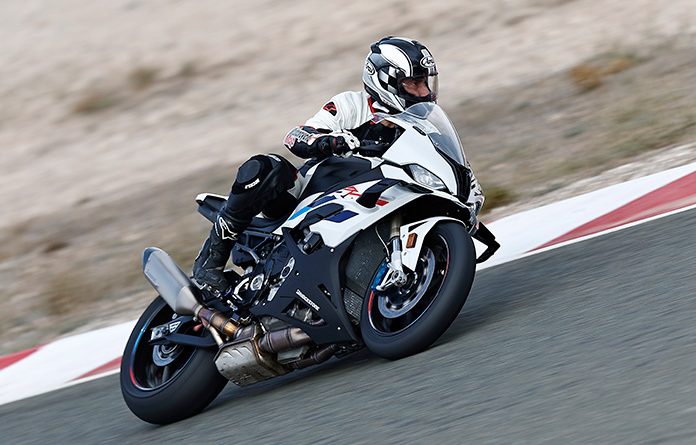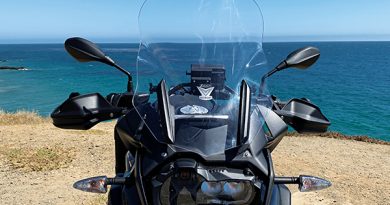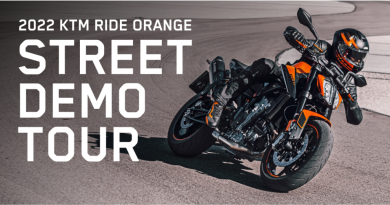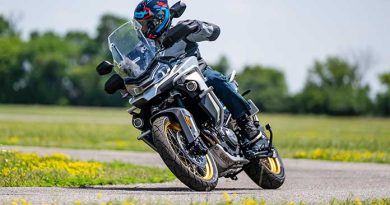2023 BMW S 1000 RR and M 1000 R | First Ride Review
A quick glance at the speedometer revealed it was displaying 175 mph before I hit the brakes hard for the upcoming right-hand turn – and that was in just the 5th of six gears. No, this was not – nor should it ever be – on a public road. It was at the end of the long back straight at Spain’s 2.6-mile Almeria Circuit during the press intro of the 2023 BMW S 1000 RR and M 1000 RR. Following a complete redesign in 2019, BMW made some revisions to its flagship S 1000 RR sportbike for 2023, and the changes have made what was already a potent supersport machine even better.
See all of Rider‘s BMW coverage here
2023 BMW S 1000 RR
When BMW launched the S 1000 RR in 2009, the German manufacturer set a new benchmark in supersport performance. Until then, open-class supersport machines produced power in the mid-170s to 180-hp range, and very few had traction control or any other form of advanced electronic rider aids.
Then the S 1000 RR came along claiming 193 hp, and it was available with adjustable traction control, selectable ride modes, and track-ready ABS – all at a reasonable price. Electronics have evolved since then, and those on the S 1000 RR are among the most advanced available.
The new S 1000 RR borrows some tech from the higher-spec M 1000 RR, BMW’s high-priced World Superbike homologation special ($32,495 for the M vs. $17,895 for the S). The S 1000 RR’s 999cc inline Four has been updated with a new cylinder head, which now has the same intake port shape as on the M 1000 RR, though the ports are cast into the head, unlike on the M, on which the ports are milled – a much costlier process.
Like before, the S 1000 RR engine uses BMW’s ShiftCam technology, which varies valve timing and valve lift to boost low to midrange torque without sacrificing power at high revs. A new airbox, also borrowed from the M, now uses computer-controlled, variable-length intake snorkels. The engine produces a claimed 205 hp at 13,000 rpm and 83 lb-ft of torque at 11,000 rpm, with the rev limiter kicking in at 14,600 rpm. The final drive ratio has been lowered by adding a tooth to the rear sprocket, to 46 teeth from 45.
Cradling the engine is a new frame that has more flex – which improves handling when applied properly – engineered into its beams. The steering geometry has been altered for more stability: The steering head angle has been pushed out by half a degree (now 23.6 degrees), triple clamp offset has been reduced by 0.1 inch, trail has been stretched by 0.2 inch to 3.9 inches, and wheelbase is 0.7 inch longer at 57.4 inches. The rear wheel is also easier to remove thanks to wheel spacers that won’t fall out and chamfered brake pads and caliper anchor.
The standard suspension is manually adjustable for compression and rebound damping and preload at both ends, while the optional Dynamic Damping Control (DDC) semi-adaptive suspension is electronically adjustable, either through the different ride modes or independently through the instrument panel. DDC is part of the Premium Package ($2,340).
Wet weight is a svelte 434 lb, which is only 8.5 lb more than the M 1000 RR; if you add the optional M package ($4,495), weight drops to within a pound of the M. The M package not only drops weight by replacing the stock wheels with carbon-fiber wheels and adding a lighter battery, it also includes machined foot controls, a sport seat, an adjustable swingarm pivot and adjustable rear ride height, and Ride Pro ride modes, which adds three track-ready Race Pro modes to the standard ride modes. Our test bikes were equipped with DDC and with the M package.
Visually, the biggest change to the S 1000 RR is the addition of MotoGP-inspired fairing winglets. These winglets generate up to nearly 38 pounds of downforce at speed, adding front-end grip and reducing the risk of wheelies. The tailpiece has also been redesigned to incorporate a more compact license-plate/turn-signal bracket that is easily removable for racetrack outings.
Even without any of the options packages, the S 1000 RR showcases the latest in electronic rider aids. It comes with four standard ride modes (Rain, Road, Dynamic, and Race), lean-sensitive ABS and traction control, a quickshifter, and hill-start assist as standard. Aside from the aforementioned DDC suspension and Race Pro modes, our bikes were equipped with adjustable wheelie control, launch control, a pit-lane speed limiter, and new this year, slide control and brake-slide control (the former controls rear-wheelspin to allow the bike to slide out of corners on the gas, while the latter controls the rear brake and engine braking to allow the bike to slide into corners). The ABS also has a “slick” setting when fitting race tires to the bike.
Some open-class supersport machines are incredibly fast on a racetrack but are mentally and physically demanding to ride hard, mostly because of their brutish power delivery. Five track sessions on the S 1000 RR revealed that while it is as fast as they come, it has neutral handling and its advanced electronics make it forgiving and easy to ride – “easy” being a relative term. Make no mistake, this is a bike for experts; riders with less experience should look elsewhere before stepping up to a 205-hp open-class supersport machine, even on the racetrack.
There are so many possible settings you can chose within the ride mode menus for traction- and wheelie-control intervention, throttle response, and slide- and brake-slide control that you’ll have to take your time during a track day or two to settle on a formula that work best for you – and it’ll be in there somewhere. I started the day in the Race Pro modes since our bikes were equipped with Bridgestone racing slicks. While each Pro mode has preset parameters for each of the bike’s control systems, you can also alter each individually within the TFT screen menus. I backed down traction control and ABS intervention as the sessions progressed, eventually settling on the lower settings. You can also turn off TC and ABS, but I can’t see any reason to do so if you have any sense of self-preservation. And you’d be missing out on the bike’s true potential, anyway.
Related: 2023 BMW S 1000 RR | First Look Review
The new slide control was really noticeable in the later sessions, after the race slicks began giving up some of their grip. With this feature set to minimum, which provides the least amount of slip angle, I’d open the throttle to the stop at just past the apex of the fast right-hand turn before the long back straight, and the rear would kick out just a bit and stay there until the bike straightened out. A higher setting would have allowed the rear to swing out more but at the cost of some speed and more tire wear. Ideally, no slip is ideal for quickest lap times; the slide control is really designed more to make you look fast.
The 2023 BMW S 1000 RR is at the pinnacle of supersport performance; trust the electronics, add some skill, and on a racetrack, you’ll look and feel like you’re a MotoGP star.
But maybe you don’t have MotoGP aspirations. Maybe you want something that boasts the performance of the S 1000 RR but comes in a more comfortable, street-oriented package. Well, BMW has you covered with the M 1000 R.
2023 BMW M 1000 R
Usually, manufacturers detune naked bikes that are based on their own sportbikes, like BMW did it when it stripped the S 1000 RR of its fairing to produce the S 1000 R, the latter producing 40 fewer horsepower than its double-R stablemate. But for 2023, BMW launched the M 1000 R, an all-new, higher-spec variation of the S 1000 R.
Related: 2023 BMW M 1000 RR and M 1000 R | First Look Review
BMW has not, however, toned down the M 1000 R, offering this naked bike with the same 999cc engine in the same 205-hp state of tune as the S 1000 RR supersport machine. There are a few differences, though, which make it a tad fiercer than even the RR: 4th through 6th gears are shorter, and overall gearing is shorter too, with another tooth added to the rear sprocket compared to the RR, at 47 teeth.
This added performance comes at a price, however, as the M 1000 R starts at $21,345, compared to $13,945 for the S 1000 R. But for that extra cash, the M comes with almost every available option you can get for the S 1000 R, as well as the S 1000 RR’s advanced racetrack electronics. Standard items include lightweight forged wheels (cast on the S), DDC semi-active suspension, Ride Pro ride modes, cruise control, track-ready traction control and Race ABS, wheelie control, dynamic brake control, a quickshifter, machined billet levers and foot controls, and many more standard items. Adding all of these to the S 1000 R would raise its price to a few hundred dollars more than the M’s starting price, and you’d still be down 40 hp.
The M 1000 R is a better option than the S 1000 RR supersport if you prioritize street riding over track lapping, as it has a more upright (read: more comfortable) riding position. While the seating position is more upright than on the S 1000 RR, the handlebar is still relatively low, placing you in a mild forward tuck.
The shorter gearing makes the M 1000 R pull even harder than the RR, a feeling further emphasized by the M’s more upright riding position. The shorter gearing does allow the engine to spin higher, which makes the bike buzzier at highway speeds, though the added vibes are not intrusive.
Our ride wasn’t long enough to access the M’s long-distance comfort, but I can say that pitching it about on a smooth, twisty road is more fun than a barrel of bonobos. Steering is neutral, if a tad twitchy, but that twitchiness disappears as soon as you take a deep breath and relax your grip on the wide handlebar. The chassis feels taut, and the suspension is firm even in the softest settings. The suspension is nonetheless compliant despite its firmness, and it’s not harsh, though you will find yourself zigzagging on broken pavement – an ADV bike this is not.
A quick stint on the racetrack revealed that the M’s wider, taller handlebar makes it more fun to ride than the S 1000 RR because the added leverage makes it easier to throw into turns. Of course, since it lacks the streamlining of the RR’s fairing, you do have to fight the wind at speed – and it will go fast. A quick glance at the M’s speedometer at the end of Alemria’s long straight showed 160 mph and climbing, though this time the bike was in top gear.
BMW Motorrad hasn’t been resting on its laurels since the introduction of the S 1000 RR, and the changes introduced for 2023 will assure it remains near the top of the performance ladder. That statement extends to the M 1000 R, which is as capable as the S 1000 RR since it is now essentially the same machine without the bodywork. Just a bit rowdier, which we don’t mind one bit.
2023 BMW S 1000 RR / M 1000 R Specs
Base Price: $17,895 / $21,345
Price as Tested: $25,425 / $22,040
Website: BMWMotorcycles.com
Warranty: 36 yrs., unltd. miles
Engine Type: Liquid-cooled, transverse inline-Four, DOHC w/ 4 valves per cyl. & ShiftCam variable valve timing
Displacement: 999cc
Bore x Stroke: 80.0 x 49.7mm
Horsepower: 205 hp @ 13,000 rpm (claimed, at the crank)
Torque: 83 lb-ft @ 11,000 rpm (claimed, at the crank)
Transmission: 6-speed, cable-actuated slip/assist wet clutch
Final Drive: O-ring chain
Wheelbase: 57.4 in. / 57.1 in.
Rake/Trail: 23.6 degrees/3.9 in. / 24 degrees/3.8 in.
Seat Height: 32.8 in. / 33.1 in.
Wet Weight: 434 lb / 439 lb
Fuel Capacity: 4.3 gals.
The post 2023 BMW S 1000 RR and M 1000 R | First Ride Review first appeared on Rider Magazine.




